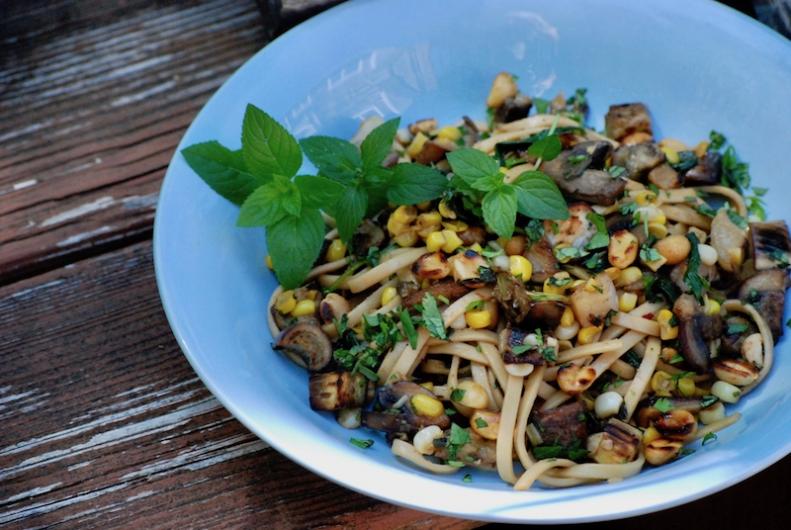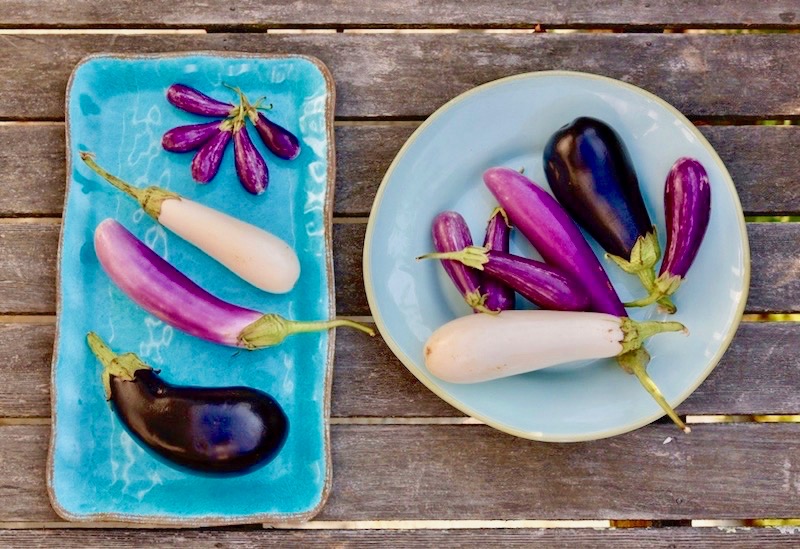It’s a sultry week in late August. One hot evening you find yourself staring at the basket of voluptuous, colorful eggplants you’ve collected from the garden or picked up at Ghost Island Farm or Morning Glory or the farmers’ market. You do not feel like whipping up eggplant parmesan or moussaka or even baba ganoush on a Tuesday night. This is no time for a culinary school exercise, it’s just dinner. But these crazy vegetables are begging you to make use of them. Now what?
The answer is much easier than you think: slice them, dice them, grill them, sauté or stir-fry them. You don’t need to salt them, wait an hour, do flips or anything else. You don’t even have to peel the skin (though you can score the skin with a fork if you really want to — and even that’s only advisable with bigger globe eggplants).
You just want to keep two goals in mind when cooking eggplant: browning it to bring out its best flavor and cooking the dense flesh all the way through. (Raw eggplant flesh isn’t terribly pleasant.)
Fortunately, those two things happen at approximately the same time if you use high-heat cooking methods—and cut your eggplant fairly uniformly and in relatively small pieces.
Essentially, the only way raw eggplant flesh becomes silky and tender is from steaming — from the inside out. A combination of direct heat (a hot pan, a hot grill) and indirect heat (residual heat bouncing around a crowded sauté or stir-fry pan or inside a hot oven or covered grill) releases moisture in the flesh and softens it. Heat can penetrate a thin slice of eggplant more easily than a thick one, and the same thing is true for small dice or half moons rather than chunks or boulders.
At this point in the nerdy science discussion, apoloigies for being so technical. All I’m really saying is that you can dice up your eggplant (about half-inch square), throw it into a hot pan, stir-fry or sauté it until brown and tender and basically do anything you want with it. The recipe for udon noodles with eggplant, corn and peanuts I’ve included here is just one way to use eggplant in a weeknight dish — the kind of all-in-one dish that functions as a main dish for vegetarians or a side for meaties.
You can use stir-fried eggplant in fried rice, in tacos, in warm salads, in grain salads, as a pizza topping, in a chickpea sauté, in summer pastas, and as the start for a quick ratatouille. (Recipe here.) Keep eggplant’s flavor partners in mind when improvising: tomatoes, olives, fresh cheeses, sesame and tahini, ginger and garlic, soy sauce or miso, mint, basil, walnuts and pine nuts, and assertive greens like arugula and watercress.

One more technical note: There is a bit of magic to how crowded your pan is when sautéing or stir-frying. You never want to be so crowded that vegetables are on top of each other; they will simply steam but not brown. At the same time, you want to have enough vegetables in the pan so that they help each other cook; as they move around the pan bumping into each other they’ll give off moisture. This is why I like a nonstick stir-fry pan; the bowl shape offers a big surface area for direct browning but also captures a bit of steam (indirect heat) to help the veggies cook.
While I prefer dice or small pieces like quarter moons for the sauté pan, eggplant slices are perfect for roasting or the grill. I think the ideal thickness is about 3/8-inch for roasting, maybe a smidge thicker for the grill. To roast, heat the oven to 425 or 450 degrees, line a sheet with parchment paper and spread the slices on the pan. Brush them liberally with oil on both sides (the oil draws the heat into the flesh) and sprinkle lightly with kosher salt. Roast (flipping once with a spatula if you like) until a rich reddish-brown color covers both sides, about 20 to 25 minutes total.
Slices destined for the grill should get the oil treatment as well. While grilling can really amp up the flavor of eggplant (it’s already smoky — add a little char or smoke from hardwood and you’ve got a lot of umami working) by caramelizing the exterior, sometimes the outside of the eggplant is heading towards being overdone before the flesh is cooked through. When this happens, I use this trick: I pull the slices off, stack them and wrap them in aluminum foil for 5 to 10 minutes. The residual heat then steams the flesh through.
Roasted or grilled slices are great on their own, drizzled with a green herb sauce like chimichurri or basil pesto. But it’s also fun to make eggplant stacks: Layer the slices with fresh mozzarella, pesto or basil leaves, and tomatoes (or even better, roasted tomatoes) to make a lovely little tower. Drizzle with a little balsamic glaze to finish. The stack can be the centerpiece of a green salad or a side for grilled lamb or steak. You can make eggplant sandwiches, too, by spreading herbed goat cheese between two slices. Grilled or roasted slices are also nice tucked into tomato gratins or arranged in a dish with a little fresh garden tomato sauce and shaved parmesan and broiled (kind of a weeknight Parmigiano).
Of course, you don’t have to dice or slice eggplant; there are many methods for cooking it whole and scooping out the flesh — it just doesn’t happen to be something I do much, especially on weeknights. I do like grilling or roasting halved eggplants (especially small Italian ones), a technique I learned in my Fine Cooking magazine days and which you may recognize from the cover of Yotam Ottolenghi’s first American cookbook, Plenty. Halved eggplants get scored deeply with a sharp knife in a crisscross pattern and then marinated before being cooked, cut side down. Scoring not only brings the marinade into the flesh but it helps transport heat, too. If you’re interested in learning to cook more with eggplant, any of Ottolenghi’s books is a good purchase.
The other reason I like cutting eggplants into manageable, uniform pieces this time of year is that you can pretty much do it with any variety or any size — even the sweet little purple and white striped Fairy Tale eggplants. I used to grow and sell a lot of Fairy Tales at my farmstand and I’m happy that I see them around more; I just bought some at Morning Glory. They have a particularly creamy and delicious flesh when cooked, and the skin is very tender, making them absolutely the easiest eggplant to deal with for weeknight cooking.
In one of my cookbooks, I did a recipe with Fairy Tales where I sliced the little vegetables lengthwise (three or four slices) but kept the stem end intact. Brushed with oil and grilled, the slices relax and fan out. The fans are fun and pretty (though the skin loses its color), but I think that treatment is fussy for weeknights. You can simply slice Fairy Tales across into coins for stir-fries, or, with the smallest, nip the end off and slice them lengthwise. The lengthwise shape does well on the grill if you use an enameled-steel grill basket.

After Fairy Tales, I’m most fond of the long, thin Japanese eggplants. Not only do they come in beautiful hues ranging from lilac to deep purple, but their flesh is firm when cooked and less seedy. Slicing them up into half moons or quarter moons (no peeling) is a no-brainer. Lately, I’ve cooked with some of the white eggplants, too; the Ghost variety is quite seedy with a pretty sturdy skin, but mild and very tasty. The flesh is exceptionally firm when cooked. But color and even shape can be a bit deceiving; there are long, white Asian eggplants as well as more stout Italian eggplants. So my advice to you is to buy a variety of eggplants at local markets and try them. This is a great opportunity we have now with all our farms; grocery stores offer far fewer varieties and because eggplants don’t travel very well, quality and flavor can be diminished.
And since eggplants are technically perennial plants, they will keep fruiting and ripening through mid-October on the Vineyard, so once the weather changes, you can make your eggplant casseroles, too — with homemade Vineyard tomato sauce.
Recipe for Stir-Fried Eggplant with Corn and Peanuts here.







